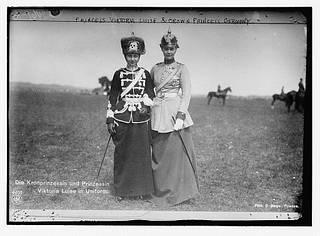
Similar
Princess Viktoria Luise and Crown Princess of Germany
Summary
Photograph shows Crown Princess Cecilie Auguste Marie of Mecklenburg-Schwerin (1886-1954), wife of German Crown Prince William (left) wearing her Dragoon regiment uniform and Victoria Louise of Prussia (the Duchess of Brunswick) in the uniform of her personal Hussar Regiment. (Source: Flickr Commons project, 2011)
The beginning of the twentieth century was a period of dramatic change for women in the West. In the late Victorian period women were constricted by a patriarchal social structure. But the early twentieth century saw the creation of the Suffragette movement, the catalyst for the rapid social change that occurred over the rest of the century. With career options other than marriage and motherhood opening up to them, women engaged with politics, served in the two world wars, made an impact on the artistic and literary worlds and experienced social and sexual liberation. Between 1880 and 1910, the number of women employed in the United States increased from 2.6 million to 7.8 million. Women's organizations in towns and cities across the U.S. were working to promote suffrage, better schools, the regulation of child labor, women in unions, and liquor prohibition. By emphasizing traditional traits, female social reformers created new spaces for themselves in local and then national government even before they had the right to vote.
The Diminished Class. Faces of Monarchies. Portraits of disappeared, replaced but survived class.
In 1225, the Teutonic Knights, a military order of crusading knights, headquartered in the Kingdom of Jerusalem at Acre transferred their operations to the Baltic Sea where Order engaged in numerous armed conflicts until Order's lands came into the hands of a branch of the Hohenzollern family, who already ruled the Brandenburg. The resulting state, known as Brandenburg-Prussia, commonly known as "Prussia", consisted of geographically disconnected territories in Prussia, Brandenburg, and the Rhineland. During the Thirty Years' War (1618–1648), armies repeatedly marched across the territories so Hohenzollerns had to build a powerful military to protect disconnected lands. "Prussia" developed one of the most powerful armies in Europe. Mirabeau said: "Prussia, is not a state with an army, but an army with a state." More than 20,000 Protestant refugees from Salzburg settled in thinly populated eastern Prussia. Prussia engaged in wars with Poland, Lithuania, numerous German States, Habsburg Austria, France, and Russia proving Prussia's status as one of the great powers of Europe. By 1813, Prussia could mobilize almost 300,000 soldiers. Prussian troops contributed crucially in the Battle of Waterloo - the final victory over Napoleon. Prussia invited the immigration of Protestant refugees (especially Huguenots). For protestants, Prussia was a safe haven in much the same way that the United States welcomed immigrants seeking freedom in the 19th century. Frederick the Great, the first "King of Prussia" introduced a general civil code, abolished torture and established the principle that the Crown would not interfere in matters of justice. He promoted an advanced secondary education which prepares the brightest pupils for university studies. The Prussian education system was emulated in various countries, including the United States. The first half of the 19th century saw a prolonged struggle between those who wanted a united Germany and others who wanted to maintain Germany as a patchwork of independent, monarchical states with Prussia and Austria competing for influence. In 1862 Prussian King Wilhelm I appointed Otto von Bismarck as Prime Minister. Bismarck guided Prussia through a series of wars resulting in a formation of the North German Confederation that united all German-speaking peoples, excluding Austria, which remained connected to non-German territories. On 18 January 1871, William was proclaimed "German Emperor". World War I ended Prussia’s supremacy. The abolition of the political power of the aristocracy transformed Prussia into a region strongly dominated by the left-wing of the political spectrum. Prussia lost territories and became a Land under the Weimar Republic. After the rise to power of Adolf Hitler in 1933, the Prussian constitution was set aside and the legislature abolished. World War II led to the abolition of Prussia with most the land ceded over to Poland. The German population was expelled and fled to the Western occupation zones. The number of casualties is estimated at 2 to 4 million, including those who fled during the last months of the war. 25 February 1947, Prussia was officially proclaimed to be dissolved.
Tags
Date
Contributors
Source
Copyright info

































